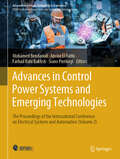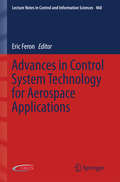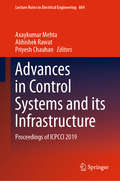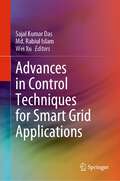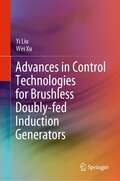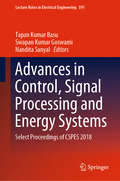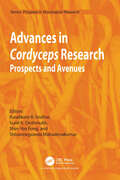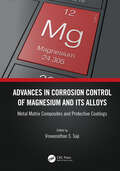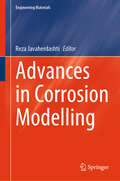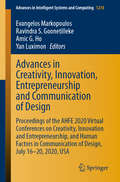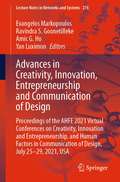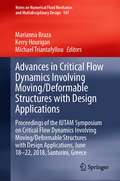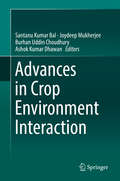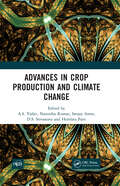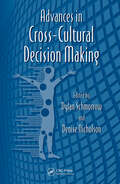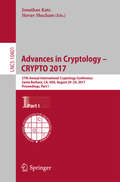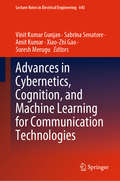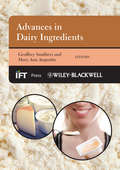- Table View
- List View
Advances in Control Power Systems and Emerging Technologies: The Proceedings of the International Conference on Electrical Systems and Automation (Volume 2) (Advances in Science, Technology & Innovation)
by Farhad Ilahi Bakhsh Mohamed Bendaoud Amine El Fathi Siano PierluigiThis edited book is an outcome of the selected papers presented at the International Conference on Electrical Systems & Automation, (ICESA 2023) held from 29 to 30 May 2023 at the Faculty of Sciences and Technologies, Al Hoceïma, Morocco. This edited book is divided into two volumes. This volume is divided into four parts, each devoted to distinct yet interconnected aspects of the subject matter. The first part presents the control of electrical machines and power converters. It covers a comparative study of different control approaches, including Proportional-Integral (PI), Fuzzy Logic, and Neural Fuzzy Logic Controllers for Boost Converters. It also presents an innovative approach for single-phase half-bridge inverters and improved direct torque control of dual three-phase permanent magnet synchronous motors. Part 2 of the book, titled "Control Systems & Automation", thoroughly explores advanced control and automation technologies in electrical systems. These chapters collectivelyshowcase the latest developments and research across various engineering domains. Several control approaches have been discussed such as fuzzy control, sliding mode control, artificial neural networks (ANN), and machine learning. The third part highlights emerging technologies and applications in various fields such as mobile robots, industry 4.0, agriculture, and health. The chapters cover a wide range of topics, including intelligent navigation for autonomous robots, self-driving car perception and pedestrian detection, machine learning for cloud and IoT-based smart agriculture, outdoor navigation systems for micro-tractors, healthcare intelligent systems for melanoma image classification, maximizing the performance of Light Emitting Diode Luminaires. The research explores innovative solutions and technologies in different domains, aiming to improve functionality in various applications. Part 4 of this book is dedicated to "Advanced Wireless Communication and Antenna Technology". This part explores cutting-edge developments and innovations in the realm of wireless communication and antenna design, with a focus on their applications and impact in various fields.
Advances in Control System Technology for Aerospace Applications (Lecture Notes in Control and Information Sciences #460)
by Eric FeronThis book is devoted to Control System Technology applied to aerospace and covers the four disciplines Cognitive Engineering, Computer Science, Operations Research, and Servo-Mechanisms. This edited book follows a workshop held at the Georgia Institute of Technology in June 2012, where the today's most important aerospace challenges, including aerospace autonomy, safety-critical embedded software engineering, and modern air transportation were discussed over the course of two days of intense interactions among leading aerospace engineers and scientists. Its content provide a snapshot of today's aerospace control research and its future, including Autonomy in space applications, Control in space applications, Autonomy in aeronautical applications, Air transportation, and Safety-critical software engineering.
Advances in Control Systems and its Infrastructure: Proceedings of ICPCCI 2019 (Lecture Notes in Electrical Engineering #604)
by Axaykumar Mehta Abhishek Rawat Priyesh ChauhanThis book gathers selected research papers presented at the International Conference on Power, Control and Communication Infrastructure 2019 (ICPCCI 2019), organized by the Institute of Infrastructure, Technology, Research and Management (IITRAM), Ahmedabad, Gujarat, India, on July 4–5, 2019. It presents the latest advances, trends and challenges in control system technologies and infrastructures. The book addresses a range of solutions to the problems faced by engineers and researchers to design and develop controllers for emerging areas like smart grid, integration of renewable energy, automated highway systems, haptics, unmanned aerial vehicles, sensor networks, robotics, formation control and many more. The solutions discussed in this book encourage and inspire researchers, industry professionals and policymakers to put these methods into practice.
Advances in Control Techniques for Smart Grid Applications
by Wei Xu Md. Rabiul Islam Sajal Kumar DasTo meet the increasing demand of electrical power, the use of renewable energy-based smart grid is attracting significant attention in recent years throughout the world. The high penetration of renewable power in the smart grids is growing its importance due to its non-finishing, reusable, reliable, sustainable, lower cost, and available characteristics. The renewable energy-based smart grid technology may mitigate the increasing energy demands effectively and efficiently without hampering the environment. But the uncertain nature of renewable sources largely affects the operation of the smart grid by un-stabling the voltage and frequency that may introduces power quality and reliability problems, which requires special control techniques. This book investigates the challenges in controlling renewable energy-based smart grids and proposes different control techniques to control the voltage and frequency effectively to improve the power quality and reliability of the power grids. This book is a valuable resource for readers interested in practical solutions in smart grids and renewable energy systems.
Advances in Control Technologies for Brushless Doubly-fed Induction Generators
by Wei Xu Yi LiuThis book presents advances in control technologies for efficient operation of the brushless doubly-fed induction generator (BDFIG). For robust and low-cost operation of BDFIGs, it is required to keep high-quality output voltage and eliminate the speed/position encoder under different loads and operation conditions. Some advanced control technologies, from the authors’ latest work on these topics, are presented to achieve this goal with simple and accurate texts, illustrations, and tables. The qualified outcomes obtained from this book assure the high-performance operation of BDFIGs and also give the readers a straight insight toward challenges in this research area in the future.
Advances in Control, Signal Processing and Energy Systems: Select Proceedings of CSPES 2018 (Lecture Notes in Electrical Engineering #591)
by Tapan Kumar Basu Swapan Kumar Goswami Nandita SanyalThis book comprises select proceedings of the National Conference on Control, Signal Processing, Energy and Power Systems (CSPES 2018). The book covers topics on both theoretical control systems and their applications across engineering domains such as automatic control, robotics, and adaptive controller design. It discusses several signal processing domains such as image, speech, biomedical signal processing and their applications in IOT, control, robotics, power and energy systems. The book emphasizes both conventional and non-conventional energy, environment, and green processes as related to energy and power systems engineering. The contents of this book will prove to be useful for students, researchers, academics, and professionals.
Advances in Cordyceps Research: Prospects and Avenues (Progress in Mycological Research)
by Sunil K. Deshmukh Kandikere R. Sridhar Shin-Yee Fung Shivannegowda MahadevakumarThe genus Cordyceps and allied species, such as entomopathogenic fungi, mainly parasitize insects and other arthropods and have been known since ancient times. They are a source of hundreds of metabolites of medicinal significance used in drug discovery and drug development.The book reviews the developments in cordyceps research and its applications. It covers areas such as diversity, distribution, taxonomy, phylogeny, genetics, bioactive potential, nutraceutical values, biotechnological prospects, plant protection, safety concerns, and marketed products. Further, the impact of human interference as well as climate change on the habitats of Cordyceps has been discussed. The book is meant for readers with an interest in mycology and allied areas. It is also invaluable to personnel carrying out research in disciplines like applied biology, biochemistry, biotechnology, botany, ecology, entomology, environmental biology, field biology, forestry, and zoology.
Advances in Core Computer Science-Based Technologies: Papers in Honor of Professor Nikolaos Alexandris (Learning and Analytics in Intelligent Systems #14)
by Maria Virvou George A. TsihrintzisThis book introduces readers to some of the most significant advances in core computer science-based technologies. At the dawn of the 4th Industrial Revolution, the field of computer science-based technologies is growing continuously and rapidly, and is developing both in itself and in terms of its applications in many other disciplines. Written by leading experts and consisting of 18 chapters, the book is divided into seven parts: (1) Computer Science-based Technologies in Education, (2) Computer Science-based Technologies in Risk Assessment and Readiness, (3) Computer Science-based Technologies in IoT, Blockchains and Electronic Money, (4) Computer Science-based Technologies in Mobile Computing, (5) Computer Science-based Technologies in Scheduling and Transportation, (6) Computer Science-based Technologies in Medicine and Biology, and (7) Theoretical Advances in Computer Science with Significant Potential Applications in Technology. Featuring an extensive list of bibliographic references at the end of each chapter to help readers probe further into the application areas of interest to them, this book is intended for professors, researchers, scientists, engineers and students in computer science-related disciplines. It is also useful for those from other disciplines wanting to become well versed in some of the latest computer science-based technologies.
Advances in Corrosion Control of Magnesium and its Alloys: Metal Matrix Composites and Protective Coatings
by Viswanathan S. SajiMagnesium (Mg) and its alloys have received widespread acceptance in automobile industries and biomedical applications with substantial recent advancements made in their development, however a significant limitation remains their poor aqueous and galvanic corrosion resistance. This book covers both the fundamentals and recent advancements in two major corrosion protection strategies of magnesium and its alloys, namely, metal-matrix composites and protective coatings.Key features: Covers all aspects of metal-matrix composites and protective coatings for magnesium alloys to improve their corrosion resistance, wear resistance, mechanical properties and biocompatibility Provides the most recent research advancements in the corrosion mitigation strategies of magnesium and its alloys Complete with case studies specific to practical applications, this book serves as a ready reference for graduate students, researchers, engineers and industry professionals in the fields of materials, corrosion science, biofouling and protective coatings.
Advances in Corrosion Modelling (Engineering Materials)
by Reza JavaherdashtiThis book is devoted to explaining advanced modelling practices of corrosion management. The eleven expert-authored chapters cover various aspects of corrosion management, from the basics of corrosion and its underlying definitions and concepts to the use of specific methods such as fuzzy logic or TRIZ (Russian: Theory of Inventive Problem Solving) for modeling specific corrosion management practices or assets like pipelines. It features modeling of various corrosion processes and reactions via numerical analysis, machine learning, fuzzy calculus, and fuzzy logic. Each chapter is written by an expert in the field with significant experience, ensuring that the content is up-to-date and of the highest quality. This book is an essential resource for professionals in the industry who seek to enhance their understanding of corrosion and its management through state-of-the-art modeling methods.
Advances in Creativity, Innovation, Entrepreneurship and Communication of Design: Proceedings of the AHFE 2020 Virtual Conferences on Creativity, Innovation and Entrepreneurship, and Human Factors in Communication of Design, July 16-20, 2020, USA (Advances in Intelligent Systems and Computing #1218)
by Ravindra S. Goonetilleke Amic G. Ho Evangelos Markopoulos Yan LuximonThis book brings together experts from different areas to show how creativity drives design and innovation to allow the integration of a wider spectrum of topics related to engineering design, industrial design and ergonomics in design. It presents theories and best practices demonstrating how creativity generates technological invention, and how this, combined with entrepreneurship, leads to business innovation. It also discusses strategies to teach creativity and entrepreneurial competencies. Moreover, the book discusses the role of human factors in understanding, communicating with and engaging users, reporting on innovative approaches, new typographies, visual elements and technologies applied to mobile and computer interfaces developments. It also discusses innovative strategies for design education and sustainable design. Based on the AHFE 2020 Virtual Conference on Creativity, Innovation and Entrepreneurship and on the AHFE 2020 Virtual Conference on Human Factors in Communication of Design, held on July 16–20, 2020, this book offers a fresh perspective and novel insights for human factors researchers, designers, communicators and innovators.
Advances in Creativity, Innovation, Entrepreneurship and Communication of Design: Proceedings of the AHFE 2021 Virtual Conferences on Creativity, Innovation and Entrepreneurship, and Human Factors in Communication of Design, July 25-29, 2021, USA (Lecture Notes in Networks and Systems #276)
by Ravindra S. Goonetilleke Amic G. Ho Evangelos Markopoulos Yan LuximonThis book brings together experts from different areas to show how creativity drives design and innovation in different kind of businesses. It presents theories and best practices demonstrating how creativity generates technological invention, and how this, combined with entrepreneurship, leads to business innovation. It also discusses strategies to teach entrepreneurial competencies and support business developments, including aspects such as corporate social responsibility and sustainability. Moreover, the book discusses the role of human factors in understanding, communicating with and engaging users, reporting on innovative approaches for product design, development, and branding. It also discusses applications in education and well-being. Based on the AHFE 2021 Conferences on Creativity, Innovation and Entrepreneurship, and Human Factors in Communication of Design, held virtually on July 25–29 July, 2021, from USA, the book addresses a broad audience of business innovators, entrepreneurs, designers, and marketing and communication experts alike.
Advances in Critical Flow Dynamics Involving Moving/Deformable Structures with Design Applications: Proceedings of the IUTAM Symposium on Critical Flow Dynamics involving Moving/Deformable Structures with Design applications, June 18-22, 2018, Santorini, Greece (Notes on Numerical Fluid Mechanics and Multidisciplinary Design #147)
by Marianna Braza Kerry Hourigan Michael TriantafyllouThis book reports on the latest knowledge concerning critical phenomena arising in fluid-structure interaction due to movement and/or deformation of bodies. The focus of the book is on reporting progress in understanding turbulence and flow control to improve aerodynamic / hydrodynamic performance by reducing drag, increasing lift or thrust and reducing noise under critical conditions that may result in massive separation, strong vortex dynamics, amplification of harmful instabilities (flutter, buffet), and flow -induced vibrations. Theory together with large-scale simulations and experiments have revealed new features of turbulent flow in the boundary layer over bodies and in thin shear layers immediately downstream of separation. New insights into turbulent flow interacting with actively deformable structures, leading to new ways of adapting and controlling the body shape and vibrations to respond to these critical conditions, are investigated. The book covers new features of turbulent flows in boundary layers over wings and in shear layers immediately downstream: studies of natural and artificially generated fluctuations; reduction of noise and drag; and electromechanical conversion topics. Smart actuators as well as how smart designs lead to considerable benefits compared with conventional methods are also extensively discussed. Based on contributions presented at the IUTAM Symposium “Critical Flow Dynamics involving Moving/Deformable Structures with Design applications”, held in June 18-22, 2018, in Santorini, Greece, the book provides readers with extensive information about current theories, methods and challenges in flow and turbulence control, and practical knowledge about how to use this information together with smart and bio-inspired design tools to improve aerodynamic and hydrodynamic design and safety.
Advances in Crop Environment Interaction
by Joydeep Mukherjee Santanu Kumar Bal Burhan Uddin Choudhury Ashok Kumar Dhawan<p>Agriculture is currently facing multi-faceted threats in the form of unpredictable weather variability, frequent droughts and scarcity of irrigation water, together with the degradation of soil resources and declining environmental health. These stresses result in the modification of plant physiology to impart greater resilience to changing abiotic and biotic environments, but only at the cost of declining plant productivity. In light of these facts, assessing the status of natural resource bases, and understanding the mechanisms of soil-plant-environment interactions so as to devise adaptation and mitigation approaches, represent great and imminent challenges for all of us. In this context, it is essential to understand the potential applications of modern tools, existing coping mechanisms and their integration, as this will allow us to develop suitable advanced mitigation strategies. <p>From a broader perspective, the book deals with crop-environment interaction in the context of changing climatic conditions. To do so, it addresses four major aspects: <p> <li>Understanding the mechanism of carbon dynamics in the soil-plant-environment continuum; greenhouse gas fluxes in agricultural systems; and soil properties influenced by climate change and carbon sequestration processes. <li>Mitigation and management of the photo-thermal environment to improve crop productivity; soil health under variable climate; reducing agro-ecosystem evapotranspiration losses through biophysical controls; and heat stress in field crops and its management. <li>Studying the impact of climate change on biotic environments; insect-pest interactions; manifestations of disease; and adaptation strategies for island agro-ecosystems. <li>Innovative approaches to assess stress impacts in crops, such as crop modeling, remote sensing, spectral stress indices etc.</li> <p> <p>The book presents a collection of contributions from authoritative experts in their respective fields. Offering young researchers new perspectives and future research directions, it represents a valuable guide for graduate students and academics alike.</p>
Advances in Crop Production and Climate Change
by Narendra Kumar Sanjay Arora A. S. Yadav D. S. Srivastava Hemlata PantThis book has comprehensive coverage and advances in agriculture for sustainable development and is expected to provide valuable sources for scholars and researchers, as well as serve as a guide book to the farmer’s community and development agencies. The book is organized into 18 chapters, which include advances in production technologies of crops e.g. rice, wheat, barley, maize, pearl millet, pulses and oilseeds; sugarcane; medicinal and aromatic plants; vegetable crops; fodder crops; resource conservation technologies; management of degraded and sodic lands; soil biodiversity; farm mechanization, etc. The text is illustrated with tables, figures and photographs to bring out the significant findings. The book provides cutting-edge scientific knowledge as well as solid background information that are accessible for those who have a strong interest in agricultural research and development and want to learn more on the challenges facing the global agricultural production systems.Note: T&F does not sell or distribute the Hardback in India, Pakistan, Nepal, Bhutan, Bangladesh and Sri Lanka. This title is co-published with New India Publishing Agency.
Advances in Cross-Cultural Decision Making (Advances in Human Factors and Ergonomics Series)
by Denise Nicholson Dylan SchmorrowThe primary focus of the Cross Cultural Decision Making field is specifically on the intersections between psychosocial theory provided from the social sciences and methods of computational modeling provided from computer science and mathematics. While the majority of research challenges that arise out of such an intersection fall quite reasonably
Advances in Cryptology – CRYPTO 2017: 37th Annual International Cryptology Conference, Santa Barbara, CA, USA, August 20–24, 2017, Proceedings, Part I (Lecture Notes in Computer Science #10401)
by Jonathan Katz Hovav ShachamThe three volume-set, LNCS 10401, LNCS 10402, and LNCS 10403, constitutes the refereed proceedings of the 37th Annual International Cryptology Conference, CRYPTO 2017, held in Santa Barbara, CA, USA, in August 2017. The 72 revised full papers presented were carefully reviewed and selected from 311 submissions. The papers are organized in the following topical sections: functional encryption; foundations; two-party computation; bitcoin; multiparty computation; award papers; obfuscation; conditional disclosure of secrets; OT and ORAM; quantum; hash functions; lattices; signatures; block ciphers; authenticated encryption; public-key encryption, stream ciphers, lattice crypto; leakage and subversion; symmetric-key crypto, and real-world crypto.
Advances in Cryptology – EUROCRYPT 2023: 42nd Annual International Conference on the Theory and Applications of Cryptographic Techniques, Lyon, France, April 23–27, 2023, Proceedings, Part II (Lecture Notes in Computer Science #14005)
by Martijn Stam Carmit HazayThis five-volume set, LNCS 14004 - 14008 constitutes the refereed proceedings of the 42nd Annual International Conference on Theory and Applications of Cryptographic Techniques, Eurocrypt 2023, which was held in Lyon, France, in April 2023.The total of 109 full papers presented were carefully selected from 415 submissions. They are organized in topical sections as follows: Theoretical Foundations; Public Key Primitives with Advanced Functionalities; Classic Public Key Cryptography; Secure and Efficient Implementation, Cryptographic Engineering, and Real-World Cryptography; Symmetric Cryptology; and finally Multi-Party Computation and Zero-Knowledge.
Advances in Cyber Security Analytics and Decision Systems (EAI/Springer Innovations in Communication and Computing)
by Atulya K. Nagar Shishir K. Shandilya Neal WagnerThis book contains research contributions from leading cyber security scholars from around the world. The authors provide comprehensive coverage of various cyber security topics, while highlighting recent trends. The book also contains a compendium of definitions and explanations of concepts, processes, acronyms, and comprehensive references on existing literature and research on cyber security and analytics, information sciences, decision systems, digital forensics, and related fields. As a whole, the book is a solid reference for dynamic and innovative research in the field, with a focus on design and development of future-ready cyber security measures. Topics include defenses against ransomware, phishing, malware, botnets, insider threats, and many others.
Advances in Cyber Security: Technology, Operations, and Experiences
by D. Frank Hsu Dorothy MarinucciAs you read this, your computer is in jeopardy of being hacked and your identity being stolen. Read this book to protect yourselves from this threat.The world’s foremost cyber security experts, from Ruby Lee, Ph.D., the Forrest G. Hamrick professor of engineering and Director of the Princeton Architecture Laboratory for Multimedia and Security (PALMS) at Princeton University; to Nick Mankovich, Chief Information Security Officer of Royal Philips Electronics; toFBI Director Robert S. Mueller III; to Special Assistant to the President Howard A. Schmidt, share critical practical knowledge on how the cyberspace ecosystem is structured, how it functions, and what we can do to protect it and ourselves from attack and exploitation.The proliferation of social networking and advancement of information technology provide endless benefits in our living and working environments. However, these benefits also bring horrors in various forms of cyber threats and exploitations. Advances in Cyber Security collects the wisdom of cyber security professionals and practitioners from government, academia, and industry across national and international boundaries to provide ways and means to secure and sustain the cyberspace ecosystem. Readers are given a first-hand look at critical intelligence on cybercrime and security—including details of real-life operations. The vast, useful knowledge and experience shared in this essential new volume enables cyber citizens and cyber professionals alike to conceive novel ideas and construct feasible and practical solutions for defending against all kinds of adversaries and attacks.Among the many important topics covered in this collection are building a secure cyberspace ecosystem; public–private partnership to secure cyberspace; operation and law enforcement to protect our cyber citizens and to safeguard our cyber infrastructure; and strategy and policy issues to secure and sustain our cyberecosystem.
Advances in Cyber Security: Third International Conference, ACeS 2021, Penang, Malaysia, August 24–25, 2021, Revised Selected Papers (Communications in Computer and Information Science #1487)
by Mohammed Anbar Nibras Abdullah Selvakumar ManickamThis book presents refereed proceedings of the Third International Conference on Advances in Cyber Security, ACeS 2021, held in Penang, Malaysia, in August 2021. The 36 full papers were carefully reviewed and selected from 92 submissions. The papers are organized in the following topical sections: Internet of Things, Industry 4.0 and Blockchain, and Cryptology; Digital Forensics and Surveillance, Botnet and Malware, DDoS, and Intrusion Detection/Prevention; Ambient Cloud and Edge Computing, SDN, Wireless and Cellular Communication; Governance, Social Media, Mobile and Web, Data Privacy, Data Policy and Fake News.
Advances in Cybernetics, Cognition, and Machine Learning for Communication Technologies (Lecture Notes in Electrical Engineering #643)
by Amit Kumar Vinit Kumar Gunjan Xiao-Zhi Gao Sabrina Senatore Suresh MeruguThis book highlights recent advances in Cybernetics, Machine Learning and Cognitive Science applied to Communications Engineering and Technologies, and presents high-quality research conducted by experts in this area. It provides a valuable reference guide for students, researchers and industry practitioners who want to keep abreast of the latest developments in this dynamic, exciting and interesting research field of communication engineering, driven by next-generation IT-enabled techniques. The book will also benefit practitioners whose work involves the development of communication systems using advanced cybernetics, data processing, swarm intelligence and cyber-physical systems; applied mathematicians; and developers of embedded and real-time systems. Moreover, it shares insights into applying concepts from Machine Learning, Cognitive Science, Cybernetics and other areas of artificial intelligence to wireless and mobile systems, control systems and biomedical engineering.
Advances in Cybersecurity Management
by Kevin Daimi Cathryn PeoplesThis book concentrates on a wide range of advances related to IT cybersecurity management. The topics covered in this book include, among others, management techniques in security, IT risk management, the impact of technologies and techniques on security management, regulatory techniques and issues, surveillance technologies, security policies, security for protocol management, location management, GOS management, resource management, channel management, and mobility management. The authors also discuss digital contents copyright protection, system security management, network security management, security management in network equipment, storage area networks (SAN) management, information security management, government security policy, web penetration testing, security operations, and vulnerabilities management. The authors introduce the concepts, techniques, methods, approaches and trends needed by cybersecurity management specialists and educators for keeping current their cybersecurity management knowledge. Further, they provide a glimpse of future directions where cybersecurity management techniques, policies, applications, and theories are headed. The book is a rich collection of carefully selected and reviewed manuscripts written by diverse cybersecurity management experts in the listed fields and edited by prominent cybersecurity management researchers and specialists.
Advances in Cybersecurity, Cybercrimes, and Smart Emerging Technologies (Engineering Cyber-Physical Systems and Critical Infrastructures #4)
by Wojciech Mazurczyk Yassine Maleh Ahmed A. Abd El-Latif Mohammed ELAffendi Mohamed I. AlkanhalThis book gathers the proceedings of the International conference on Cybersecurity, Cybercrimes, and Smart Emerging Technologies, held on May 10–11, 2022, in Riyadh, Saudi Arabia. The conference organized by the College of Computer Science of Prince Sultan University, Saudi Arabia. This book provides an opportunity to account for state-of-the-art works, future trends impacting cybersecurity, cybercrimes, and smart emerging technologies, that concern to organizations and individuals, thus creating new research opportunities, focusing on elucidating the challenges, opportunities, and inter-dependencies that are just around the corner. This book is helpful for students and researchers as well as practitioners. CCSET 2022 was devoted to advances in cybersecurity, cybercime, and smart emerging technologies. It was considered a meeting point for researchers and practitioners to implement advanced information technologies into various industries. There were 89 paper submissions from 25 countries. Each submission was reviewed by at least three chairs or PC members and 26 regular papers (30%) were accepted. Unfortunately, due to limitations of conference topics and edited volumes, the Program Committee was forced to reject some interesting papers, which did not satisfy these topics or publisher requirements.
Advances in Dairy Ingredients (Institute of Food Technologists Series #79)
by Geoffrey W. Smithers Mary Ann AugustinAdvances in Dairy Ingredients provides an international perspective on recent developments in the area of dairy ingredients and dairy technology. Market and manufacturing trends and opportunities are aligned with the latest science tools that provide the foundation to successfully and rapidly capture these opportunities. Functional foods are emerging as key drivers of the global food economy and dairy ingredients and technology are at the forefront in these developments. Advances in Dairy Ingredients brings together food scientists, industry specialists, and marketers from around the world to provide unique insight into the scientific basis for the success of dairy ingredients in modern food products, and a glimpse into the future of new dairy ingredients and foods on the horizon.
